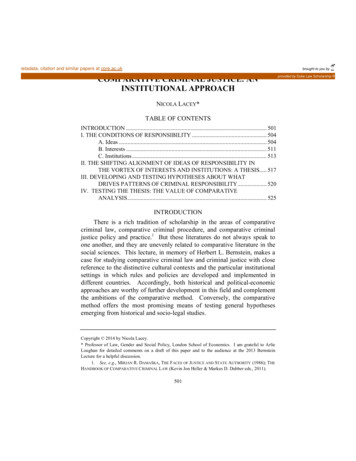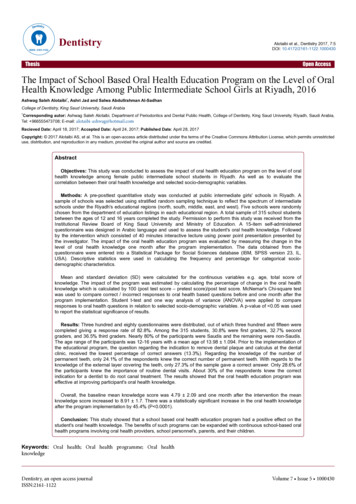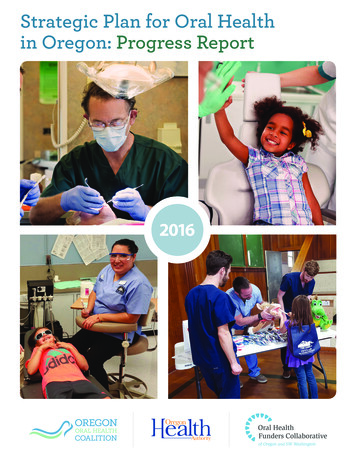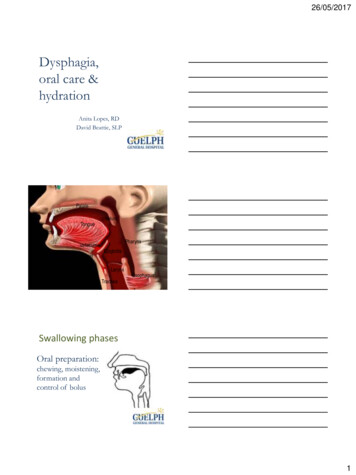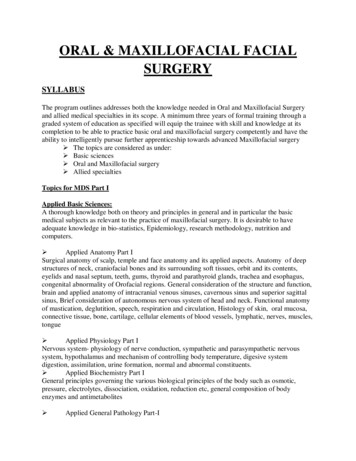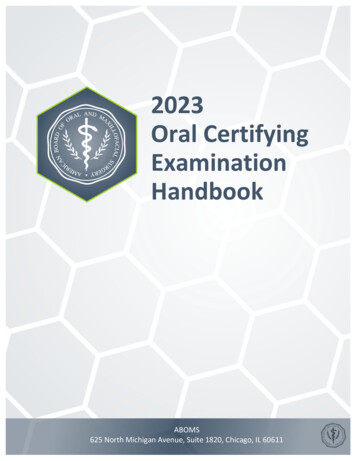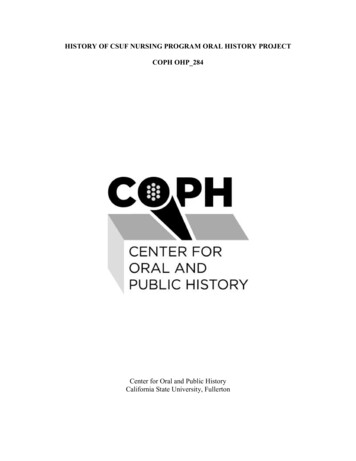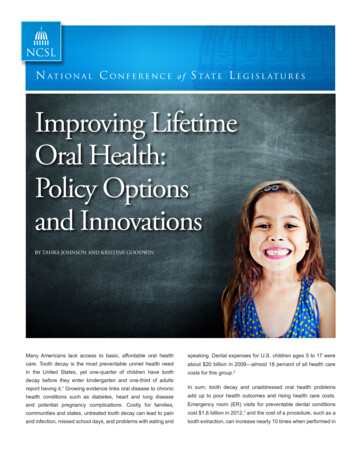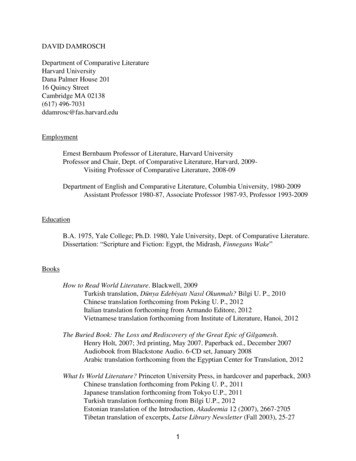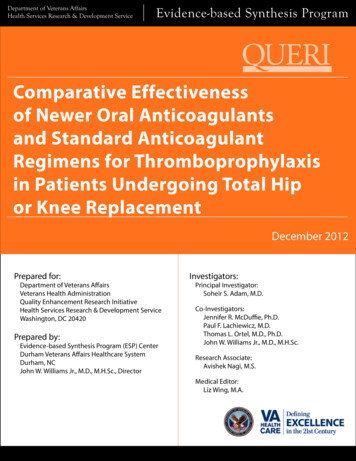
Transcription
Department of Veterans AffairsHealth Services Research & Development ServiceEvidence-based Synthesis ProgramComparative Effectivenessof Newer Oral Anticoagulantsand Standard AnticoagulantRegimens for Thromboprophylaxisin Patients Undergoing Total Hipor Knee ReplacementDecember 2012Prepared for:Department of Veterans AffairsVeterans Health AdministrationQuality Enhancement Research InitiativeHealth Services Research & Development ServiceWashington, DC 20420Prepared by:Evidence-based Synthesis Program (ESP) CenterDurham Veterans Affairs Healthcare SystemDurham, NCJohn W. Williams Jr., M.D., M.H.Sc., DirectorInvestigators:Principal Investigator:Soheir S. Adam, M.D.Co-Investigators:Jennifer R. McDuffie, Ph.D.Paul F. Lachiewicz, M.D.Thomas L. Ortel, M.D., Ph.D.John W. Williams Jr., M.D., M.H.Sc.Research Associate:Avishek Nagi, M.S.Medical Editor:Liz Wing, M.A.
Comparative Effectiveness of New Oral Anticoagulantsfor ThromboprophylaxisEvidence-based Synthesis ProgramPREFACEQuality Enhancement Research Initiative’s (QUERI’s) Evidence-based Synthesis Program (ESP)was established to provide timely and accurate syntheses of targeted healthcare topics of particularimportance to Veterans Affairs (VA) managers and policymakers, as they work to improve thehealth and healthcare of Veterans. The ESP disseminates these reports throughout VA.QUERI provides funding for four ESP Centers and each Center has an active VA affiliation. The ESPCenters generate evidence syntheses on important clinical practice topics, and these reports help: develop clinical policies informed by evidence, guide the implementation of effective services to improve patientoutcomes and to support VA clinical practice guidelines and performancemeasures, and set the direction for future research to address gaps in clinical knowledge.In 2009, the ESP Coordinating Center was created to expand the capacity of QUERI CentralOffice and the four ESP sites by developing and maintaining program processes. In addition,the Center established a Steering Committee comprised of QUERI field-based investigators,VA Patient Care Services, Office of Quality and Performance, and Veterans Integrated ServiceNetworks (VISN) Clinical Management Officers. The Steering Committee provides programoversight, guides strategic planning, coordinates dissemination activities, and developscollaborations with VA leadership to identify new ESP topics of importance to Veterans and theVA healthcare system.Comments on this evidence report are welcome and can be sent to Nicole Floyd, ESPCoordinating Center Program Manager, at nicole.floyd@va.gov.Recommended citation: Adam SS, McDuffie JR, Lachiewicz PF, Ortel TL, Williams JW Jr.Comparative Effectiveness of Newer Oral Anticoagulants and Standard Anticoagulant Regimensfor Thromboprophylaxis in Patients Undergoing Total Hip or Knee Replacement. VA ESP Project#09-010; 2012.This report is based on research conducted by the Evidence-based Synthesis Program (ESP)Center located at the Durham VA Medical Center, Durham, NC, funded by the Department ofVeterans Affairs, Veterans Health Administration, Office of Research and Development, HealthServices Research and Development. The findings and conclusions in this document are those ofthe author(s) who are responsible for its contents; the findings and conclusions do not necessarilyrepresent the views of the Department of Veterans Affairs or the United States government.Therefore, no statement in this article should be construed as an official position of theDepartment of Veterans Affairs. Potential conflicts of interest: Dr. Ortel: Grants–GlaxoSmithKline,Eisai, Daichi Sankyo, Pfizer, Instrumentation Laboratory; Consultancy–Boehringer Ingelheim,Pfizer, Instrumentation Laboratory. No other investigators have any affiliations or financialinvolvement (e.g., employment, consultancies, honoraria, stock ownership or options, experttestimony, grants or patents received or pending, or royalties) that conflict with material presentedin the report. To limit conflict of interest, Dr. Ortel participated in the design and critical review ofthe report but did not participate in data abstraction or drafting of the report.i
Comparative Effectiveness of New Oral Anticoagulantsfor ThromboprophylaxisEvidence-based Synthesis ProgramEXECUTIVE SUMMARYBACKGROUNDVenous thromboembolic (VTE) events are important causes of morbidity in elective totalhip replacement (THR) and total knee replacement (TKR) procedures. Current guidelinesrecommend thromboprophylaxis in patients undergoing THR or TKR, although the AmericanAcademy of Orthopaedic Surgeons (AAOS) guidelines suggest individual assessment ofpatients when choosing the specific thromboprophylaxis strategy. Low molecular weightheparin (LMWH) and adjusted-dose warfarin are the most commonly used anticoagulants forthromboprophylaxis in the United States, but a number of other treatment options are available,including unfractionated heparin, aspirin, mechanical devices, and newer oral anticoagulants.Prior to 1980, rates of symptomatic VTE were 15 to 30 percent. However, improved surgicalcare and techniques have decreased the rate of symptomatic VTE. A recent analysis thatincorporated data from trials and observational studies estimated the contemporary 35-day rate ofsymptomatic VTE without thromboprophylaxis at 4.3 percent.Pharmacological thromboprophylaxis for THR or TKR surgery decreases VTE by approximately50 percent but with the tradeoff of increased bleeding. The risk of bleeding is a concern becausebleeding can lead to infections, reoperation, delayed wound healing, and extended hospitalstay. The choice of which antithrombotic thus becomes pivotal for balancing the prevention ofthromboembolism with the risk of bleeding. Newer oral anticoagulants have been developedwith the goal of overcoming the limitations of warfarin and the available parenteral agents.These newer anticoagulants belong to two drug classes, based on their target coagulation protein:factor Xa (FXa) inhibitors and direct thrombin inhibitors (DTIs). These drugs are given as fixedoral doses and have the advantage of a more predictable anticoagulant effect, eliminating theneed for monitoring when used for short-term thromboprophylaxis. Disadvantages of neweroral anticoagulants include the lack of specific antidotes to reverse their anticoagulant effect in atimely fashion in case of bleeding, and drug costs.Given the emerging data on new oral anticoagulants, this report was commissioned by the VA toexamine the following key questions (KQs):KQ 1. For patients undergoing total hip or total knee replacement, what is the comparativeeffectiveness of newer oral anticoagulants and standard drug classes (low molecular weightheparin, injectable factor Xa inhibitors, unfractionated heparin, warfarin, aspirin) on theincidence of symptomatic, objectively confirmed venous thromboembolism (VTE), other VTEevents, total mortality, and bleeding outcomes?KQ 2. For patients undergoing total hip or total knee replacement, what are the effects ofcombined pharmacological and mechanical modalities versus pharmacological treatment aloneon the incidence of symptomatic, objectively confirmed VTE, other VTE events, total mortality,and bleeding outcomes?KQ 3. For patients undergoing total hip or total knee replacement, what is the comparativeefficacy of individual newer oral anticoagulants on the incidence of symptomatic, objectivelyconfirmed VTE, other VTE events, total mortality, and bleeding outcomes?1
Comparative Effectiveness of New Oral Anticoagulantsfor ThromboprophylaxisEvidence-based Synthesis ProgramMETHODSDuring the topic development phase of this study, we identified a number of published highquality systematic reviews that addressed our KQs. We conducted a synthesis of these reviewsas they pertained to the KQs and the Veteran population and followed a standard protocol forall steps of this review. We searched MEDLINE (via PubMed ), Embase , and the CochraneDatabase of Systematic Reviews for systematic review publications comparing the newer oralanticoagulants to other types of anticoagulation (aspirin, warfarin, LMWH, unfractionated heparin,etc.) from January 2009 through September 2012. Our search strategy used the National Library ofMedicine’s medical subject headings (MeSH) keyword nomenclature and text words for newer oralanticoagulants, the conditions of interest, and validated search terms for systematic reviews.Using prespecified inclusion and exclusion criteria, two reviewers assessed titles and abstractsfor relevance to the KQs. Full-text systematic reviews identified by either reviewer aspotentially relevant were retrieved for further review. Select data from published reports werethen abstracted into the final abstraction form by a trained reviewer. All data abstractions wereconfirmed by a second reviewer. We also abstracted data necessary for assessing the qualityof systematic reviews, adapted from the AMSTAR criteria. Based on these criteria, systematicreviews were categorized as good, fair, or poor quality. Poor-quality reviews were excluded.DATA SYNTHESISWe categorized each systematic review by the key research questions they addressed andcritically analyzed them to compare their characteristics, methods, and findings. We summarizedthe key findings and conclusions from each included review and produced summary tablesfor comparison across reviews. We prioritized the evidence from these reviews by the qualityof methodological designs, more complete drug comparisons, and detailed information aboutpopulation, specific drug intervention, and definitions of outcomes. In addition to summarymeasures of relative effects (e.g., risk ratios), we report absolute risk differences in the summarystrength of evidence tables. For these estimates, baseline risk for patients treated with LMWH—the common comparator for newer anticoagulants—was estimated for each major outcome assymptomatic deep vein thrombosis (DVT), 9 per 1000 patients; nonfatal pulmonary embolism(PE), 3 per 1000 patients; mortality, 3 per 1000 patients; and major bleeding, 7 per 1000 patients.Our synthesis focused on identifying patterns in efficacy and safety of the different drugs.To determine the consistency of results and conclusions, we then compared each additionalreview that addressed the same key question. If findings or conclusions differed importantlyacross reviews, we analyzed potential reasons for discrepancies such as the primary literatureincluded, inclusion/exclusion criteria, differences in outcome definition, analytic approach, andconflict of interest. Because total hip and knee replacement have distinct primary endpoints, weexamined the groups of studies as they pertained to these diagnoses separately.RATING THE BODY OF EVIDENCEIn addition to rating the quality of individual studies, we evaluated the overall quality of theevidence for each KQ. In brief, this approach requires assessment of four domains: risk of bias,2
Comparative Effectiveness of New Oral Anticoagulantsfor ThromboprophylaxisEvidence-based Synthesis Programconsistency, directness, and precision. For risk of bias, we considered study design using the qualityassessments of the primary literature reported in the systematic reviews. We used results from metaanalyses when evaluating consistency, precision, strength of association, and whether publicationbias was detected. Optimal information size and consideration of whether the confidence intervalcrossed the clinical decision threshold for a therapy were also used when evaluating precision.PEER REVIEWA draft version of the report was reviewed by technical experts and clinical leadership. Atranscript of their comments can be found in the appendix, which elucidates how each commentwas considered in the final report.RESULTSOur search for systematic reviews (SRs) identified 182 unique citations from a combinedsearch of MEDLINE via PubMed, Embase, the Cochrane Database of Systematic Reviews,and bibliographies of key articles. After applying inclusion and exclusion criteria at both thetitle-and-abstract and full-text review levels, the final set of articles used in this evidence reportconsisted of six recently published, high-quality systematic reviews.All of the SRs compared newer oral anticoagulants with other drug classes used forthromboprophylaxis in THR or TKR (KQ 1), but specific strategies varied. Two SRs usedrandom-effects meta-analyses to compare drug classes as a whole (e.g., FXa inhibitors versusLMWH) while the other four SRs compared individual drugs, some analyzing THR and TKRstudies separately. Two of the six SRs compared one newer oral anticoagulant with another (KQ3) though all results were based on indirect comparisons; i.e., through common comparison withenoxaparin. Only one SR compared a pharmacological agent plus mechanical modality versuspharmacologic prophylaxis alone (KQ 2).All reviews assessed the quality of included trials, and overall quality was judged to begood. Publication bias was assessed and did not indicate bias that would favor newer oralanticoagulants. Three of the SRs were unfunded and reported no conflicts of interest. One SRwas unfunded but did report a conflict of interest for one author. Two SRs were funded bygovernment agencies.Key Question 1. For patients undergoing total hip or total knee replacement,what is the comparative effectiveness of newer oral anticoagulants and standarddrug classes (low molecular weight heparin, injectable factor Xa inhibitors,unfractionated heparin, warfarin, aspirin) on the incidence of symptomatic,objectively confirmed venous thromboembolism (VTE), other VTE events, totalmortality, and bleeding outcomes?Key Points For all-cause mortality and nonfatal PE, there were no important differences betweenoral FXa inhibitors and LMWH (high strength of evidence). Using a base rate of 9 events3
Comparative Effectiveness of New Oral Anticoagulantsfor Thromboprophylaxis Evidence-based Synthesis Programper 1000 patients with LMWH, FXa inhibitors were associated with lower symptomaticDVT (4 fewer events per 1000 patients; 95% CI, 3 to 6). Overall, FXa inhibitors wereassociated with an increased risk of major bleeding, but major bleeding did not differimportantly at low to moderate doses (moderate strength of evidence). Based on subgroupanalyses, there was not a consistent pattern of differences in treatment effects for THRand TKR.There were fewer studies evaluating oral DTIs than oral FXa inhibitors; all trialscompared dabigatran with enoxaparin. Although estimates of effect were often imprecise,there were no significant differences between oral DTIs and enoxaparin for any majoroutcome.Neither oral FXa inhibitors nor DTIs have been compared directly with adjusted-dosewarfarin, oral antiplatelet drugs, or unfractionated heparin in existing SRs.FXa inhibitors. Rivaroxaban and apixaban are the most commonly studied FXa inhibitors, andrivaroxaban is the only FXa inhibitor marketed in the United States. The risk of symptomaticDVT was reduced with FXa inhibitors compared with LMWH, while the risks of nonfatal PEand mortality were not significantly different (all high strength of evidence). The estimatedabsolute risk difference was 4 fewer symptomatic DVT events for each 1000 patients receivingthromboprophylaxis with FXa inhibitors over 5 weeks compared with LMWH. However,these benefits were offset by an increase in major bleeding (moderate strength of evidence).The absolute risk difference was 2 more major bleeding events per 1000 patients receivingthromboprophylaxis with FXa inhibitors over 5 weeks. Higher doses of FXa inhibitors, but notintermediate or low doses, were associated with increased major bleeding. Subgroup analysisby specific drug and type of surgery showed a reduced risk of bleeding with apixaban comparedwith LMWH in TKR but not in THR; risk of major bleeding with rivaroxaban did not differsignificantly for either surgery. No reviews identified trials comparing oral FXa inhibitors withwarfarin, unfractionated heparin, or oral antiplatelet agents.Direct thrombin inhibitors. Dabigatran is the only FDA-approved oral DTI and the onlyDTI evaluated in existing SRs. Compared with LMWH, dabigatran was not associated withsignificant differences for any outcome examined. The strength of evidence was low formost outcomes due to few events and imprecise estimates of effect; also, effects on mortalityvaried substantially across studies. In addition to the major outcomes, a subgroup analysis inone SR found no significant difference between both treatment groups on bleeding requiringrehospitalization. No reviews identified trials comparing oral DTIs with warfarin, unfractionatedheparin, or oral antiplatelet agents. Table 1 summarizes the findings and strength of evidencefor the effects of newer oral anticoagulant drug classes compared with enoxaparin in patientsundergoing THR or TKR surgery.4
Comparative Effectiveness of New Oral Anticoagulants for ThromboprophylaxisEvidence-based Synthesis ProgramTable 1. Summary of the strength of evidence for KQ 1Domains Pertaining to SOENumberof Studies(Subjects)OutcomeStudy ation BiasEffect Estimate (95% CI)SOEFXa vs. LMWHaMortality (up to 10 weeks)11 (22,838)RCT/GoodConsistentDirectPreciseNone detectedOR 0.95 (0.55 to 1.63)RD 0 (2 fewer to 1 more) deaths/1000 patientsHighSymptomatic DVT(up to 5 weeks)18 (22,877)RCT/GoodConsistentDirectPreciseNone detectedOR 0.46 (0.30 to 0.70)RD 4 fewer (3 to 6 fewer) events/1000 patientsHighNonfatal PE(up to 5 weeks)20 (26,998)RCT/GoodConsistentDirectPreciseNone detectedOR 1.07 (0.65 to 1.73)RD 0 (1 fewer to 2 more) events/1000 patientsHighMajor bleeding(up to 5 weeks)21 (31,424)RCT/GoodInconsistentDirectPreciseNone detectedOR 1.27 (0.98 to 1.65)RD 2 more (0 to 4 more) events/1000 patientsModerateMortality (up to 13 weeks)4 (10,080)RCT/GoodInconsistentDirectImpreciseNone detectedTKRRR 1.06 (0.36 to 3.12)RD 0 (2 fewer to 6 more) events/1000 patientsTHRRR 1.17 (0.04 to 36.52)RD 0 (3 fewer to 107 more) events/1000patientsLowSymptomatic DVT(up to 5 weeks)4 (10,264)RCT/GoodConsistentDirectImpreciseNone detectedRR 0.82 (0.17 to 3.99)RD 2 fewer (7 fewer to 27 more) events/1000patientsLowSymptomatic PE(up to 5 weeks)4 (10,264)RCT/GoodConsistentDirectImpreciseNone detectedOR 0.69 (0.31 to 1.54)RD 1 fewer (2 fewer to 2 more) events/1000patientsLowMajor bleeding(up to 5 weeks)4 (10,264)RCT/GoodConsistentDirectImpreciseNone detectedRR 0.94 (0.58 to 1.52)RD 0 (3 fewer to 3 more) events/1000 patientsModerateNANANANot estimableInsufficientLMWH vs. DTIbFXa or DTI vs. other antithromboticsAll outcomes0Data from Neumann, 2012.Risk ratio data from Ringerike, 2012, and Gómez-Outes, 2012; risk difference calculated; SOE ratings from Sobieraj, 2012.Notes: Outcomes are short-term; there may be some differences for hip versus knee replacement (different baseline risk and different duration of anticoagulation in existing studies); there is someevidence that FXa inhibitors at higher doses increase risk of bleeding.Abbreviations: CI confidence interval; DVT deep vein thrombosis; DTI direct thrombin inhibitor; FXa factor X inhibitor; LMWH low molecular weight heparin; NA not applicable; OR oddsratio; PE pulmonary embolism; RCT randomized controlled trial; RD risk difference; RR risk ratio; SOE strength of evidence; THR total hip replacement; TKR total knee replacementab5
Comparative Effectiveness of New Oral Anticoagulantsfor ThromboprophylaxisEvidence-based Synthesis ProgramKey Question 2. For patients undergoing total hip or total knee replacement, whatare the effects of combined pharmacological and mechanical modalities versuspharmacological treatment alone on the incidence of symptomatic, objectivelyconfirmed VTE, other VTE events, total mortality, and bleeding outcomes?Key Points In the included SRs, no studies were identified that compared the combination of neweroral anticoagulants and mechanical thromboprophylaxis with pharmacological treatmentalone.Few studies compared older antithrombotics (LMWH, oral antiplatelet agents, orunfractionated heparin) combined with mechanical prophylaxis to pharmacological ormechanical prophylaxis alone.The strength of evidence is insufficient to determine the comparative effectiveness forcombined pharmacological and mechanical prophylaxis compared with pharmacologicalprophylaxis alone for all major outcomes prioritized for this report.No reviews identified trials comparing newer oral anticoagulants combined with mechanicalprophylaxis to pharmacological prophylaxis alone. Even when considering standard treatments,very little data are available comparing combined-modality thromboprophylaxis and pharmacologicprophylaxis only. One SR found moderate strength of evidence that combined-modalitythromboprophylaxis was associated with a decreased risk of overall DVT (including asymptomaticevents) compared with pharmacologic prophylaxis alone. The evidence was insufficient for all otheroutcomes.Key Question 3. For patients undergoing total hip or total knee replacement,what is the comparative efficacy of individual newer oral anticoagulants on theincidence of symptomatic, objectively confirmed VTE, other VTE events, totalmortality, and bleeding outcomes?Key Points No clinical trials directly compared newer oral anticoagulants with each other forthromboprophylaxis of THR or TKR.The included SRs did not estimate the comparative efficacy of newer oral anticoagulantsfor symptomatic DVT, nonfatal PE, all-cause mortality, or surgical site bleeding.Based on indirect comparisons, there were few differences between newer oralanticoagulants for the outcomes examined. Rivaroxaban was associated with moremajor bleeding than apixaban (RR 1.59; 95% CI, 0.84 to 3.02). In contrast, the risk ofsymptomatic VTE was lower for rivaroxaban than apixaban or dabigatran, but confidenceintervals included the possibility of a chance association.Only indirect comparisons of rivaroxaban, apixaban, and dabigatran were performed throughcommon comparison with LMWH. These comparisons were made for only two of our majoroutcomes—symptomatic VTE (DVT or PE) and major bleeding. There were no significantdifferences in treatment effect for symptomatic VTE or major bleeding. Because these indirectcomparisons are subject to confounding and the treatment effects were imprecise, we considered6
Comparative Effectiveness of New Oral Anticoagulantsfor ThromboprophylaxisEvidence-based Synthesis Programthe strength of evidence low. Other outcomes reported included clinically relevant bleeding andnet clinical endpoints. Rivaroxaban was found to be associated with an increased risk of clinicallyrelevant bleeding, but there was no significant difference in net clinical endpoints (symptomaticVTE, major bleeding, and death). Table 2 summarizes the findings and strength of evidence forbetween-drug comparisons of newer oral anticoagulants in patients undergoing THR or TKR.7
Comparative Effectiveness of New Oral Anticoagulants for ThromboprophylaxisEvidence-based Synthesis ProgramTable 2. Summary of the strength of evidence for KQ 3Domains Pertaining to SOENumberof Studies(Subjects)OutcomeStudy ation BiasEffect Estimate (95% CI)SOEApixaban, rivaroxaban, dabigatranaMortalityNRNANASymptomatic DVTNRNANANAOutcome not reportedInsufficientNonfatal PENRNANANAOutcome not reportedInsufficientSymptomatic VTE16 (38,747)RCT/GoodNAIndirectImpreciseRivaroxaban vs. dabigatranLowRR 0.68 (0.21 to 2.23)RD 3 fewer (11 fewer to 4 more) events/1000 patientsMajor bleeding16 (38,747)RCT/GoodNAIndirectNANone detectedImpreciseNone detectedOutcome not reportedInsufficientRivaroxaban vs. apixabanRR 0.59 (0.26 to 1.33)RD 4 fewer (9 fewer to 1 more)/1000 patientsLowApixaban vs. dabigatranRR 1.16 (0.31 to 4.28)RD 1 more (7 fewer to 8 more)/1000 patientsLowRivaroxaban vs. dabigatranLowRR 1.37 (0.21 to 2.23);RD 4 more (2 fewer to 11 more) events/1000 patientsRivaroxaban vs. apixabanRR 1.59 (0.84 to 3.02);RD 5 more (2 fewer to 12 more)/1000 patientsLowApixaban vs. dabigatranRR 1.16 (0.31 to 4.28);RD 0 (8 fewer to 7 more)/1000 patientsLowData from Gómez-Outes, 2012.Abbreviations: DVT deep vein thrombosis; NA not applicable; NR not reported; PE pulmonary embolism; RCT randomized controlled trial; RD risk difference; RR risk ratio; SOE strength ofevidence; VTE venous thromboembolisma8
Comparative Effectiveness of New Oral Anticoagulantsfor ThromboprophylaxisEvidence-based Synthesis ProgramRECOMMENDATIONS FOR FUTURE RESEARCHWe used a structured framework to identify gaps in evidence and classify why these gaps exist(Table 3).Table 3. Evidence gaps and future researchEvidence GapAbsence of direct comparisons betweennewer anticoagulant drugsReasonInsufficient informationType of Studies to ConsiderMulticenter RCTsHigh-quality network meta-analysesObservational comparativeeffectiveness studiesAbsence of direct comparisons betweennewer anticoagulants and agents otherthan LMWHInsufficient informationAbsence of comparisons betweencombined treatment with neweranticoagulants and mechanicalthromboprophylaxis to pharmacologicalor mechanical thromboprophylaxis aloneInsufficient informationAdverse effects with long-term use andin usual clinical practiceInsufficient informationMulticenter RCTsObservational comparativeeffectiveness studiesMulticenter RCTsObservational comparativeeffectiveness studiesObservational studiesAbbreviation: LMWH low molecular weight heparin; RCT randomized controlled trialCONCLUSIONFor THR or TKR, the 35-day rate of symptomatic VTE without thromboprophylaxis is estimatedto be 4.3 percent. Pharmacological thromboprophylaxis decreases VTE by approximately 50percent but with the tradeoff of increased bleeding. Newer oral anticoagulants have a moreconvenient route of administration compared with LMWH, and unlike adjusted dose warfarin,they do not require regular laboratory monitoring. Compared with LMWH, FXa inhibitorsare associated with a reduced risk of symptomatic DVT, but mortality and nonfatal PE are notsignificantly different, and the risk of major bleeding episodes is increased.There are no available studies on head-to-head comparisons of these novel anticoagulants.Longer clinical experience and direct drug-drug comparisons are needed to better assess therisk-to-benefit ratio of newer oral anticoagulants for surgical thromboprophylaxis. Based oncurrent evidence, newer anticoagulants—particularly FXa inhibitors—are a reasonable option forthromboprophylaxis in patients undergoing total hip replacement or total knee replacement.9
Comparative Effectiveness of New Oral Anticoagulantsfor ThromboprophylaxisABBREVIATIONS THRTKRVAVHAVKAVTEconfidence intervaldirect thrombin inhibitordeep vein thrombosisU.S. Food and Drug Administrationfactor Xa inhibitorinternational normalized ratiokey questionlow molecular weight heparinmedical subject headingnot applicablenot reportedodds ratiopulmonary embolismrandomized controlled trialrisk differencerisk ratiostrength of evidencetotal hip replacementtotal knee replacementDepartment of Veterans AffairsVeterans Health Administrationvitamin K antagonistvenous thromboembolism10Evidence-based Synthesis Program
Given the emerging data on new oral anticoagulants, this report was commissioned by the VA to examine the following key questions (KQs): KQ 1. . for comparison across reviews. We prioritized the evidence from these reviews by the quality of methodological designs, more complete drug comparisons, and detailed information about .

